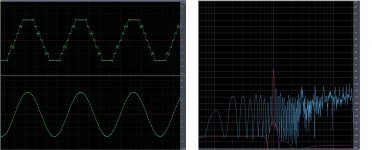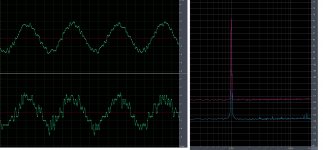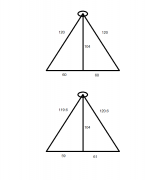OK, so here’s my little dither experiment. Bear with me as I walk through it, I am just trying a thought experiment out on (maybe) what could be done with only 16bit technology. It could be along the lines of what Barry Blesser proposed; I would have to talk with the folks here.
First picture left, bottom - “perfect” -80dB sine wave, our analog in. Top - this sine wave run through an ideal 16 bit quantizer. Please look at the samples, the wiggles are Audition showing you live sinc(x) interpolation. If you don’t believe in brickwall sinc(x) interpolation you can still ignore it.
First picture right, red- input spectra. Blue- rather horrifying spectra that would come out of a perfect NOS DAC with the left top waveform. This is exactly what is on the CBS test CD for 1 kHz, -80dB, and it is what comes out of my 24bit DAC. Turn it way up and it sounds like shite.
So now suppose you have an algorithmic noise generator that only needs a seed and starting sample. Audition only has pseudo- Gaussian noise; don’t shoot me I don’t think it matters that much here.
Second picture left, bottom input signal with -90dB noise generated at 16bits and put through a 48dB attenuator and added as a pseudo-24bit analog signal. This has then been put through the same ideal quantizer. Top - the punch line, the bottom signal through an ideal NOS DAC and the regenerated noise subtracted in the analog domain. This is a perfectly legal 16/44.1 CD data set and all you need at play would be the seed and an exact starting sample. Without it you still get a usable signal at 6dB or so dither SNR degradation. “Fuzzy distortion”?
Second picture right, red – The spectra of the left bottom signal. Blue – spectra of the top left signal.
The final result looks pretty good for a -80dB sine wave out of a nominally 16bit system. You can look at it on a sample by sample basis. If I pass an impulse through I get one out with only the added noise. Or look at the spectra, pretty heavy suppression of spurs, nothing seems to be hiding there. Is it practical, I don’t know? Maybe Barry could have been the Dolby of Digital.
EDIT - Note the scales on the spectra are not the same.
First picture left, bottom - “perfect” -80dB sine wave, our analog in. Top - this sine wave run through an ideal 16 bit quantizer. Please look at the samples, the wiggles are Audition showing you live sinc(x) interpolation. If you don’t believe in brickwall sinc(x) interpolation you can still ignore it.
First picture right, red- input spectra. Blue- rather horrifying spectra that would come out of a perfect NOS DAC with the left top waveform. This is exactly what is on the CBS test CD for 1 kHz, -80dB, and it is what comes out of my 24bit DAC. Turn it way up and it sounds like shite.
So now suppose you have an algorithmic noise generator that only needs a seed and starting sample. Audition only has pseudo- Gaussian noise; don’t shoot me I don’t think it matters that much here.
Second picture left, bottom input signal with -90dB noise generated at 16bits and put through a 48dB attenuator and added as a pseudo-24bit analog signal. This has then been put through the same ideal quantizer. Top - the punch line, the bottom signal through an ideal NOS DAC and the regenerated noise subtracted in the analog domain. This is a perfectly legal 16/44.1 CD data set and all you need at play would be the seed and an exact starting sample. Without it you still get a usable signal at 6dB or so dither SNR degradation. “Fuzzy distortion”?
Second picture right, red – The spectra of the left bottom signal. Blue – spectra of the top left signal.
The final result looks pretty good for a -80dB sine wave out of a nominally 16bit system. You can look at it on a sample by sample basis. If I pass an impulse through I get one out with only the added noise. Or look at the spectra, pretty heavy suppression of spurs, nothing seems to be hiding there. Is it practical, I don’t know? Maybe Barry could have been the Dolby of Digital.
EDIT - Note the scales on the spectra are not the same.
Attachments
Last edited:
Hi,
Well, if you don't give it some wear and tear, how do you know it is any good...?
Because I filled in the warranty card, that's how..
Huh? I hadn't noticed...😀You must forgive my German superiority complex
Cheers, jn
You must forgive my German superiority complex, which is based on the simple fact that (excluding digital audio) much that is still debated or in fashion in these days (including stealth) was worked out there in the late 30's (there was little real progress in fundamentals but much in practicals after WW2 started) and it seems very little real progress has happened since. Without that stupid war (as well as the one that followed) the world would be at least 50 Years more advanced.
Oh is that why you are always so defensive? 🙂
Scott,
Would you make Pavel happy and repeat it with a signal near 1/2 the sampling frequency?
ES
Would you make Pavel happy and repeat it with a signal near 1/2 the sampling frequency?
ES
Scott,
Would you make Pavel happy and repeat it with a signal near 1/2 the sampling frequency?
ES
ED - I said the impulse response works, so there is no point except the time spent.
Last edited:
ED - I said the impulse response works, so there is no point except the time spent.
Me bad...
SY,
To get an interchannel difference you need two channels. So if your loudspeakers are ten feet away and spaced ten feet apart, how far do you have to move so that the path length difference changes by 10 usec x 1130 ft/sec x 12 in/ft = .1356 inch (.344424 cm?)
D1 = sqrt(120 x 120 + 60 x 60) =D2initial = 134.16" D2dif = 134.16 - .1356 = 134.028
Sqrt (134.16 x 134.16 - 134.028 x 134.028) = 5.948"
ES
You've got an equilateral triangle with 120" per side. That means 104" between listener and the line connecting the two speakers. Move the listener an inch to the left, so the distance to the line between the speakers is still 104". Now you have a pathlength to the left of sqrt((104)^2 + (59)^2) = 119.6. Distance to the right speaker is sqrt((104)^2 + (59)^2) = 120.6. You can repeat this for any listener translation. Of course, this assumes that the speaker to listener position distance differential is zero to start with. Hmmm....
Attachments
SY, that is where the 10u comes from, tests with a speaker.
I think that's a different experiment, not a matter of differential delay between two channels. But if you can dig up a reference to the contrary, I'd be appreciative.
SY,
I am impressed you can move your ears independently! (Also I assume 10' from the center point not each loudspeaker.) ((Yes you can twist your head to change the distance as opposed to lateral motion, but then that is what dogs and even some people do to localize sound.))
ES
I am impressed you can move your ears independently! (Also I assume 10' from the center point not each loudspeaker.) ((Yes you can twist your head to change the distance as opposed to lateral motion, but then that is what dogs and even some people do to localize sound.))
ES
You don't need to move them independently- the differential time shift is close to independent of the inter-ear difference, which is constant for both positions.
Ed,
In my county (which is thankfully history since '89) we had a saying which travels and translates extremely poorly, but it renders in English approximatley like this:
"Those who think they know it all really **** off those that do."
Ciao T
Oh is that why you are always so defensive? 🙂
In my county (which is thankfully history since '89) we had a saying which travels and translates extremely poorly, but it renders in English approximatley like this:
"Those who think they know it all really **** off those that do."
Ciao T
SY
Somehow we ain't talkin! When you slide your head one inch to the left, both ears move. If the delay time from the left speaker is 10.00 ms to the left ear and the signal from the right speaker is also 10.00 ms, when you move a bit that may change to L 9.99 and R 10.01 but at the same time the right ear goes from L 10.00 R 10.00 to L 9.9901 to R 10.0099 or some such. It is the differential we are considering.
ES
Somehow we ain't talkin! When you slide your head one inch to the left, both ears move. If the delay time from the left speaker is 10.00 ms to the left ear and the signal from the right speaker is also 10.00 ms, when you move a bit that may change to L 9.99 and R 10.01 but at the same time the right ear goes from L 10.00 R 10.00 to L 9.9901 to R 10.0099 or some such. It is the differential we are considering.
ES
Last edited:
Ed,
In my county (which is thankfully history since '89) we had a saying which travels and translates extremely poorly, but it renders in English approximatley like this:
"Those who think they know it all really **** off those that do."
Ciao T
Oh, that explains why you get sin binned!
Scott,
How many samples compromise the window?
BTW, the "horrible" result is true.
The other one is an illusion fostered by getting the right answer to a wrong question.
Ciao T
OK, so here’s my little dither experiment.
How many samples compromise the window?
BTW, the "horrible" result is true.
The other one is an illusion fostered by getting the right answer to a wrong question.
Ciao T
Scott,
AD1862 & PDM100, NOT AD1855 (I heard that part, I'd take cirrus logic instead any day, which is about the same as saying I'd rather eat at MickeyD). It is not the manufacturer, it is the specific chip.
My personal list for 16/44 goes (either Non-Os or PDM100 for HDCD):
#1 TDA1541AS2
#2 TDA1541AS1
#3 TDA1541A
#4 AD1862
#5 PCM56
#6 PCM63
#7 and on - the rest of multibitdom
Listening to TDA1541AS2 with JAN GE 6072A ***** as analogue stage ATM...
Ciao T
Hi Thorens,
Does it make any difference whether there is only 1 DAC chip, or 2 or 4 in parallel?
Scott,
How many samples compromise the window?
BTW, the "horrible" result is true.
The other one is an illusion fostered by getting the right answer to a wrong question.
Ciao T
Please clarify? Compromise what window? The time domain waveforms are created by adding analog signals only, yes the DAC and quantizer are assumed ideal. With some work I could program SoX to do this and put some dithered then truncated music on a CD and play it back. The impulse response is an impulse with only additive noise, so propose some other "transient". I am talking looking at it on a sample by sample basis, the dither is additive noise. Forget the averaged spectrum for now, could refer you to Rice, S. O., Mathematical Analysis of Random Noise. Bell System Technical Journal 24 (1945) 46–156 for the distribution of expected values for band limited noise sampled over a given time period.
Your last comment is deliberately obfuscating, reminds me of dropped classes with teachers that didn't want to teach. The DAC photo was just a joke I didn't even look at the part number.
Last edited:
a saying
Was schon jeder weiss macht mich nicht heiss (, aber ehr-geiz ist geil)
Ed,
I get sin-binned for breaking rules or not giving (false) respect.
(I do have copies of the notices).
In my view those rules are unjust (especially given what some may be prone to interpret as selective enforcement of said rules), however they are the rules, just or not and if I break them I need to be prepared to face the music.
If you cannot do the time (or stand "enhanced interrogation"), don't stand up against those who make rules...
I do have a lot of T-Shirts in my closet.
Ciao T
Oh, that explains why you get sin binned!
I get sin-binned for breaking rules or not giving (false) respect.
(I do have copies of the notices).
In my view those rules are unjust (especially given what some may be prone to interpret as selective enforcement of said rules), however they are the rules, just or not and if I break them I need to be prepared to face the music.
If you cannot do the time (or stand "enhanced interrogation"), don't stand up against those who make rules...
I do have a lot of T-Shirts in my closet.
Ciao T
Hi,
Yes, it does.
Ciao T
Does it make any difference whether there is only 1 DAC chip, or 2 or 4 in parallel?
Yes, it does.
Ciao T
T,
You are welcome.
Somehow when I joke with some folks they get insulted and when I insult some folks they thank me! Of course there are those who don't seem to know when they have been insulted.
But the primary rule of courtesy is never duel with an unarmed man. I think that is really the rule you violate to get sin binned. You continue to duel in a battle of withs with the unarmed.
You are welcome.
Somehow when I joke with some folks they get insulted and when I insult some folks they thank me! Of course there are those who don't seem to know when they have been insulted.
But the primary rule of courtesy is never duel with an unarmed man. I think that is really the rule you violate to get sin binned. You continue to duel in a battle of withs with the unarmed.
- Status
- Not open for further replies.
- Home
- Member Areas
- The Lounge
- John Curl's Blowtorch preamplifier part II


